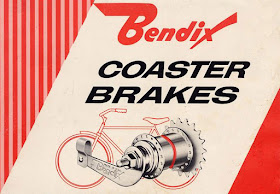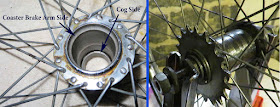
I can see a puzzled look suddenly come over the young woman’s face as she picks out a cruiser bicycle to ride at the C and O Canal Bicycle Loan program at Great Falls, Maryland. She sheepishly asks, “Where are the brakes?”
“Just pedal backwards. The bike has coaster brakes.” This information doesn’t quite compute.
“Pedal backwards. Really?”
“Try it out. People have been riding bicycles with coaster brakes without a problem for more than 100 years. The one on this bike is a Bendix Coaster brake that was popular in the 1960s.”
The forty or fifty year old bike she is going to ride is Columbia bicycle that is very popular in the program. The brake is a Bendix Model 70. Bendix began manufacturing coaster brakes in 1924 after deciding to diversify from its car parts business and to start producing bicycle components. The company produced bike parts until the demise of its bicycle division in the 1980s. During the 1950s and 1960s Bendix coaster brakes were quite common on Schwinn, Columbia and many other major bicycle brands.
The coaster brake was invented in the 1890s and ever since they have been a favored option on bicycles. New Departure was a very popular model on early 20th century bicycles. Around the same time the Wright Brothers designed and made their own coaster brakes (McCullough 2016). If you’re interested in the invention and development of coasters brakes, see my article on “A short history of coaster brakes.”
Advantages and Disadvantages of Coaster Brakes
The popularity of the coaster brake even 100 years after their invention is because of their simplicity and ease of use (Brown 2018). Coaster brakes generally require less maintenance than any other type of brake, sometimes going 50 years without needing new grease. They require no hand levers or cables that are exposed to the elements. For older or the handicapped with hand strength problems, pedaling backwards to stop a bike isn’t a problem. Without all the protruding wires, bicycles with coaster brakes have a clean look.Performance of rim or even disc brakes suffer when they get wet, but coaster brakes perform the same way no matter what the weather. Rain is not a problem for coaster brakes because it just splashes off the rear hub. All mechanical parts are conveniently sealed inside the hub with plenty of grease to keep out the elements. Coaster brakes have always been able to accommodate gears. Even the earliest models had an option for 2 speeds. Today Shimano offers a coaster brake hub with 8 speeds and a wide gear ratio.
The disadvantages of coaster brakes are that the pedals cannot be adjusted while standing over the bicycle frame. It is always a good idea to level the pedals to get a good start on a bicycle. The pedals cannot be rotated backwards to put them in a level position because this activates the brake. Coaster brakes also are difficult to feather for smooth stopping. It is possible, but not easy. The coaster brake also can be prone to locking up the wheels and causing the tire to skid. For kids this is an advantage, since they enjoy putting bikes into a sideways skid. This seemingly is a one of the requisite skills for youthful riders, especially but not exclusively boys.
Coaster brakes are not compatible with rear derailleurs or chain tensioners, making the installation of the back wheel after fixing a flat a challenge for novice mechanics. The chain may be either too loose or too tight after installing the back wheel. Coaster brakes can heat up and fade on long downhill rides in mountainous areas, but they are just fine for local hills as they cool off rapidly. Coaster brakes should have a backup front brake in case of a very rare failure. Many of the front brakes installed on less expensive bicycles are worthless and give riders a false sense of security.
For many bicyclists the benefits of coaster brakes outweigh the problems. The coaster brake won’t be seen on elite bicycles, but that is no problem for the many care-free people cruising along on coaster brake bikes and gently pedaling backwards to stop forward progress.
How Coaster Brakes Operate
I became interested in coaster brakes several years ago when a Columbia bicycle was donated to the C and O National Historic Park Canal Bicycle Loan Program in Great Falls, Maryland. The bicycle became popular in the program, but after about a year one rider came back and said the brakes don’t work properly.To investigate I take the bike on a test ride and pedal backwards. The brakes don’t engage and the bike freewheels. Yikes! I employ my alternative Fred Flintstone method of braking, dragging my feet on the ground to stop the bike. I wonder if some of the internal parts might be damaged. I decide to take the brake apart to see if it can be fixed.
After examining the contents that spill out of the hub, I’m surprised to find that after forty or fifty years of maintenance free riding, the coaster brake parts show very little sign of wear and tear. But the grease has turned into a solidified tar-like substance. The parts of this Bendix 70 coaster brake (figure 1) will have to be cleaned, greased and reassembled.
 |
Figure 1. Bendix 70 coaster brake arm from the 1950s or 1960s (Photo: Doug Barnes) |
 |
Figure 2. View of empty and assembled and empty coaster brake hub (Photo: Doug Barnes) |
Now let's look at an overview of what fell out of the hub when I opened it up (figure 3). You have a drive side that has a large screw. The screw is attached to the cog and rotates clockwise or counterclockwise depending on the pedaling direction. Fitting over the screw is the clutch. This clutch has a matching thread that goes over the screw, so it moves right and left as the rider either pedals forward or backward.
 |
Figure 3. Internal parts of a Bendix 70 coaster brake hub (Photo: Doug Barnes) |
Let’s take a closer look at how the parts in the hub work. The key to understanding how the coast brake hub works is the drive side screw which activates or deactivates the brakes. The drive screw turns with the pedal. The clutch mentioned above has a matching thread that goes over the drive screw as demonstrated on the right side of figure 4. The clutch moves left when pedaled forward and moves right when pedaled backwards. Pedaling backwards moves the clutch right which pushes the drive side expander wedging into the brake shoes between the fixed and drive side expanders. As indicated previously, these brake shoes expand and rub against the inside of the hub causing the bike to stop.
 |
Figure 4. The drive side screw and the coaster brake clutch. (Photo: Doug Barnes |
Pedaling backwards pushes the drive side expander to the left and as the name suggests expands brake shoes. The brake shoes rub against the inside of the hub resulting in friction and heat. This friction causes the back wheel to slow or stop. The friction between the brake shoes and the hub is the reason why it is advisable to use high temperature grease on the brakes shoes. Regular grease should be used in the rest of the hub.
With pedals in a neutral position—neither pedaling forward or backwards—the clutch isn't engaged with either the rim or the brakes. The result is that the bicycle freely coasts justifying its signature name.
 |
Figure 5. Internal parts of the full assembly Bendix 70 coaster brake. (Photo: Doug Barnes |
Ready for the Road
The old Bendix 70 brake has been lubricated and even after 50 years it is looking forward to many more miles of service. The coaster brake hub is still the brake of choice on many of today’s cruiser bicycles. With new grease the Columbia bicycle now works perfectly. I put this bike back in line so it can be enjoyed by those looking to experience the ride of a strong and durable old school bicycle.References
Barnes,Douglas. 1915. How Coaster Brakes Work. YouTube Video.Bendix Corporation. 1967. “Bendix Coaster Brakes: Service, Parts and Price list.” Bendix Bulletin EM 2052. Tom Findley’s Website. accessed 2018.
Brown, Sheldon. 2018 “Bicycle Coaster Brakes” Sheldon Brown’s Technical Bicycle Information Website. SheldonBrown.com. Accessed 2018.
McCullough, David. 2016. The Wright Brothers. New York: Simon and Shuster.

Thanks for the information
ReplyDeleteVery well written and illustrated. Thanks for taking the time!
ReplyDeleteJust aquires a 1960,s Schiff Stingray and absoloutky love it , being intreuged on how the breaking system works , your knoledge has provided a goodness , thnkyou x
ReplyDeletejust aquired a 1960,s Schinn... love it soooo much , your illustration on how the breaks work is most appreciated ...
ReplyDeleteThe Bendix 70 hub was introduced in 1970 and replaced the previous "red band" hub.
ReplyDeleteHave you thought of doing an expose' on the 2 gear back axle that Bendix came out with in the early 60s. I occasionally see one of those old bikes and wonder if it was secured by patent and if it's expired, still in production anywhere, et cetera.
ReplyDeleteBe sure to put grease on the brake shoes of a Bendix Coaster. I once decided to instal “power brakes” on my Coasterbile by only putting grease on the bearings and actuator screw. I washed out the entire assembly with gasoline and dried all the parts. When I rode the bike it seemed to work fine until I lightly applied the brake. The rear wheel locked up tightly and I took an instant spill over the handlebars. Next, I took the assembly apart again, lubed it properly, reassembled it and everything worked fine.
ReplyDeleteYes. Absolutely. And it is better to use high temperature grease. Also, many old coaster brakes have a cap on the hub for oil. You can flush out the dirt with something like Tri Flow and then relube the hub with a thick oil.
Delete